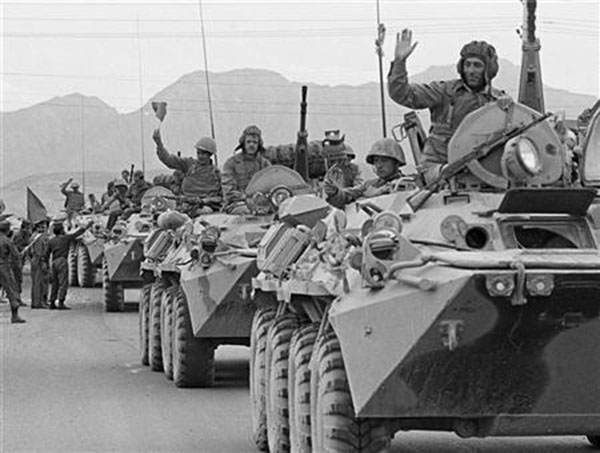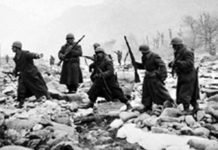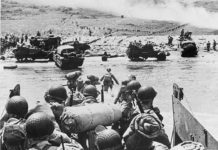
Afghanistan has resisted foreign invasions since the ancient times of Alexander the Great, who conquered the world but not the “graveyard of empires.”
On this day in history, February 15, 1989, the Soviet Union announced the last of its troops had left Afghanistan almost ten years after entering the country. Soviet authorities hailed it as a victory, but most observers felt it was a major defeat for the USSR in the Cold War.
Soviet leader Leonid Brezhnev dispatched forces to support the struggling Marxist government of the Democratic Republic of Afghanistan against the Islamist Mujahideen Resistance on December 24, 1979. The mujahideen was soon supported by the United States, Britain, Pakistan, Saudi Arabia, Egypt and other Muslim nations.
President Sayid Mohammed Najibullah’s Soviet-backed Afghan regime acknowledged the complete withdrawal of the soldiers, stating: “I express my appreciation to the people and government of the Soviet Union for all-round assistance and continued solidarity in defending Afghanistan.”
During the Soviet occupation, about a million Afghans lost their lives as the Red Army tried to impose control, and millions more fled abroad as refugees. Soviet deaths were estimated at around 15,000.
Kremlin Hailed Soldiers’ Heroism
The departing Russian forces were joined by more than 20,000 refugees fleeing the continued fighting between the mujahideen and Soviet troops, and crossed the border into Pakistan through the Khyber Pass. Some journalists were also permitted to join the Soviet troops leaving Kabul, the capital.
The mujahideen had been involved in heavy battles to force the Soviet retreat. Ahead of the departure, they fired four rockets at the capital. Then, Kabul was surrounded by a mujahideen army of 30,000, with the city coming under artillery and rocket fire.
The departure of the Red Army coincided with a decision by Mikhail Gorbachev, the last Soviet leader, to reduce total Russian armed forces by 500,000, with the Kremlin emphasizing the heroism of those who fought in the war in Afghanistan.
Najibullah was still defiant and determined to play a role in the future of his country. But the civil war continued after the Soviet withdrawal and he was toppled in 1992. Due to its seemingly never-ending nature, the Soviet-Afghan War is often called the “Soviets’ Vietnam.”
Russian History in Afghanistan
Russian military involvement in Afghanistan has a long history, dating back to czarist expansion in the “Great Game” between Russia and Britain in the 19th century. This interest in the region continued through the Soviet era, with billions in economic and military aid sent to Afghanistan from 1955-78.
The Democratic Republic of Afghanistan was a self-declared Communist state established by the Afghan Communist Party, the People’s Democratic Party of Afghanistan, and then-leader Nur Muhammad Tarakiin in a revolution in 1978.
The republic came into conflict with local mujahideen, who started the Afghan civil war. The Soviet Union invaded the country in 1979, killed the sitting president, and installed Babrak Karmal as leader. More than 100,000 Soviet troops took part in the incursion backed by another 100,000.
As part of its overall Cold War strategy, the United States responded by arming and supporting the Afghan mujahideen, who took up arms against the Soviet occupiers of their mountainous, isolated country.
The Reagan Doctrine
U.S. support began in the Carter years, but expanded during President Ronald Reagan’s administration, when it became a focus of the Reagan Doctrine, under which the United States backed anti-Communist resistance movements in Angola, Nicaragua and other nations.
The Reagan administration delivered several hundred FIM-92 Stinger surface-to-air missiles to Afghan resistance groups, including the Taliban. The mujahideen also received aid from Pakistan, Saudi Arabia and other Islamic nations.
The Soviet occupation resulted in the death of 600,000 to two million Afghan civilians. More than five million Afghans fled the country to Pakistan, Iran and other parts of the world. Faced with mounting international pressure and heavy casualties on both sides, the Soviets withdrew in 1989.
Victory for the United States
The Soviet departure was seen as an ideological and military victory in the United States, which had supported the mujahideen through three presidential administrations in order to counter Soviet influence in the oil-rich Persian Gulf.
After the removal of the Soviet forces, the United States and its allies lost interest in Afghanistan. The USSR continued to support Najibullah until 1992, when the new Russian government refused to sell oil to his regime.
Conflict continued among the victorious mujahideen factions, which led to warlordism. The most serious fighting occurred in 1994, when 10,000 people were killed in Kabul. The Taliban developed as a political and religious force, seizing Kabul in 1996 and establishing the Islamic Emirate of Afghanistan. By the end of 2000, the repressive, anti-modern Taliban controlled more than 95 percent of the country.
During the Taliban’s seven-year reign, many Afghans experienced constraints on their freedom and human rights violations. Women were banned from jobs and girls were not allowed to attend school. Communists were eradicated and thieves punished by amputation. Opium production was almost wiped out by 2001.
One day before the September 11 terrorist attacks in 2001, President George W. Bush’s administration agreed on a plan to oust the Taliban regime in Afghanistan by force if it refused to hand over al Qaeda leader Osama bin Laden.
Operation Enduring Freedom
In October 2001, following the September 11 attacks, the United States launched Operation Enduring Freedom, a military campaign to destroy al Qaeda terrorist training camps in Afghanistan.
The U.S. military also threatened to overthrow the Taliban government for refusing to turn in Osama bin Laden and other al Qaeda members. And the United States again joined with the former Afghan mujahideen to achieve its goals.
The United States sent teams of CIA paramilitary officers to invade Afghanistan and assist anti-Taliban militias, backed by U.S. air strikes against Taliban and al Qaeda targets, culminating in the seizure of Kabul by the Northern Alliance and the overthrow of the Taliban.
The hand of history weighed heavily on President Barack Obama in 2009 as he deployed 30,000 more U.S. troops to the country, with the aim of finally eradicating the Taliban insurgency. Afghanistan has a deserved reputation for thwarting ambitious military ventures and humiliating would-be conquerors.
Sources:
- Borovik, Artvom. The Hidden War: A Russian Journalist’s Account of the Soviet War in Afghanistan. 1990.
- Feifer, Gregory. The Great Gamble — the Soviet war in Afghanistan. 2009.







